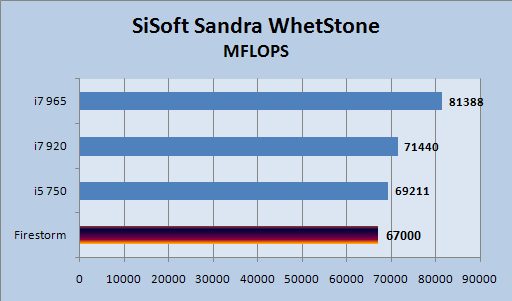Page 6 -- Benchmarks Continued
Sandra
Next we take a look at the SiSoft Sandra benchmarks, DhryStone and WhetStone.

Well, now, the Firestorm is putting up a great show here!

I re-ran this test several times, and each time, Sandra came up with a low number for its iSSE3 test. There doesn't seem to be any evidence of thermal throttling, but the number is suspiciously low. Moving on.
Let's see the game benchmarks, where overheating isn't so much of an issue.
COD4

Call of Duty 4 is a benchmark, perhaps not in hardware stress, but in gameplay. This older game doesn't stress the Firestorm one bit, and we only experienced a single crash when we were overclocking.

Most games these days are designed with consoles in mind, unfortunately. Hopefully, developers will get tired of limiting their games and start producing more and more PC tweaked versions.
Borderlands

Critical hit! Anybody keeping score here?
Borderlands is a unique game that combines elements from FPS and character-building games with a rotoscope look. It's also a blast to play! Like most games produced these days, it's originally a console game.

Of course, playing a FPS without a keyboard and mouse is just too foreign.
Battlefield Bad Company 2: Demo

Battlefield Bad Company 2 is not quite Battlefield 3, but it does feature many gameplay elements similar to Battlefield 2. While the game developer targeted consoles first, BFBC2 has a PC version that has been tweaked to take advantage of the latest hardware, including a DX11 mode. The destructable evironment is really great, too.

Yes, I realize that there are not any comparisons here, but even at minimum frames this game is very playable. This game also benefitted greatly with the SSD with load times around 18 seconds, easily beating anybody else in the multiplayer mode. This makes getting into sniping position very, very easy.
Far Cry 2

We like Far Cry 2 for its stunning graphics. It also comes with the Firestorm and includes a very handy benchmark mode.

While dipping to just below 40 FPS at the minimum, the benchmark remained very smooth. With the Very High settings, the IQ is very pleasing.

The Firestorm versus the LANShark with its GTX295 is not particularly fair, but it does give a comparison at least. Still, the average frame rate is around 50FPS, which is smooth, supple, and very kissable. I mean, playable.
Heaven

The Heaven benchmark was also included, so we ran it and grabbed a screenshot. It is a DX11 benchmark, but of course most of the DX10 code still works, so it didn't complain that we were using an nVidia GTX285. If only World of Warcraft looked this good. No, better not think it.
Cinebench R11.5
And lastly, Cinebench R11.5. This latest release is very different from R10, by testing seperately OpenGL and the CPU, and giving a score for each. It's default render isn't as cool as the motorcycle, but neat to watch at any rate.

Cinebench R11.5 is a nicely multi-threaded test of professional graphics and CPU power. The Firestorm is last on the list, but the list is populated by several dual-socket and professional GPU workstations.

Completing the suite of tests, the Firestorm does fairly well, actually.

Yes, the units don't match, but for the sake of clarity, I've included them in the same graph. The Firestorm does 25 FPS and 5.6 'points' in the Cinebench R11.5 test.
Overall, the Firestorm is what you would expect from an i7 965, GTX285, SSD monster: it's really, bloody, fast. The flames on the case suddenly make sense, it's burning through benchmarks and games. For most modern games, the Firestorm is cranking out close to 60FPS. For benchmarks, it produces just about what you would expect from an i7 965, although our results were slightly lower than the rest of the field. Certainly with some modest tweaking, the Firestorm would burn through these tests, although we do think it needs a better cooling solution to be really confident. But, I'll cover that in the next few pages. Onward, my good fellow.
